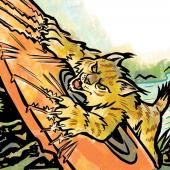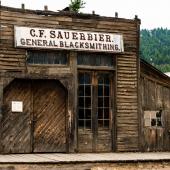The Curious Afterlife of Montana’s Ghost Towns
I had come to Elkhorn as part of a trip to see a few once thriving ghost towns —Elkhorn, Bannack, and Virginia City. Maybe I shouldn’t have been surprised since it is a ghost town but I was nevertheless surprised to see two ghosts.
The specters in question were an adolescent brother and sister. They piled out of the backseat of a hatchback and into Elkhorn’s Fraternity Hall with all the vigor of the still-quick, but their ghastly visages betrayed them. Their eyes were ringed in black paint, their hair dyed grey. Their parents followed after them, cameras around their necks raised to take what I suspect were to be the pictures on this year’s Christmas cards. Or maybe Halloween.




So it followed that like the ghosts, the towns I visited were also decidedly alive.
For instance, there are still those in Elkhorn who make the town their home, though not nearly as many as did in the late 1880s when local silver mines produced an estimated $14 million in ore. It was in those glory days that the town had regular baseball games, a candy shop, a brass band, three hotels, fourteen saloons and a two-lane bowling alley.

Then, in 1889 a diphtheria epidemic caused the death of many of the town’s small children and their mothers, a story told by the infant’s tombstones in the town’s graveyard. The passing of the Silver Purchase Act led to layoffs at the mine, and the population dwindled. The Fraternity Hall, which had once been paid for by a town-wide talent show, is now open to the public, along with the Grand Hotel.

I visited Bannack next. Its tale is also one of boom-and-bust mining, and like Elkhorn, it has refused to die.
In fact thousands of people visit the town for Bannack Days, always held on the third weekend in July, for historical reenactments, educational and entertaining displays, old-timey songs, and delicious food (the peach cobbler this year was to die for).
Bannack, named (and misspelled) for the Bannock Indians, was the first territorial capital of Montana and was built on the spot of the territory’s first major gold rush in 1862. The population grew to 3,000 a mere year later, and the town became famous, or infamous, when Sheriff Plummer began moonlighting as one of its most industrious highwaymen. He was hung in 1864 for murder and robbery.

The actor playing him in this year’s Bannack Days spun a more colorful version of the yarn involving Unionist vigilantes trying to stop Sheriff Plummer from funding the Confederates. The actor, who sported a long beard and performed his role with theatrical relish, concluded with his frank assessment of this year’s election. I thought how in ghost towns, the past and the present bleed into one another.

In the Grace United Methodist Church, completed by farmers and townspeople who came from miles around to seek protection from the Battle of the Big Hole fought by Chief Joseph in 1877, visitors sang hymns like “How Great Thou Art” and “Beulah Land.” Crowds at Bannack Day are singing the same songs that they sang then, in the same place, and presumably in the same spirit of community. They say the same doxology. The children squirm with the same sense of innocent restlessness. The lines between reenactment and the real thing, just a bunch of folk in Montana going to church, become blurred further.
Virginia City, which I visited last, has become downright sophisticated. I sat in Bob’s Place, which serves such cosmopolitan fare as a Caprese salad, Thai red curry quinoa, and polenta with pesto and fire-roasted tomatoes. Virginia City is the kind of place where you can spend a nickel on a nickelodeon burlesque, take in a turn of the century melodrama, or have your portrait taken in sepia. You can even see the beam from which road agent Clubfoot George and unrepentant cannibal Boone Helm were hung from the necks, and then you can cross the street and enjoy some artisanal huckleberry popcorn and enjoy the free wifi. The layers of time are stacked on top of one another, thin as tissues.

I talked to the folks who worked there and asked them whether the town was living or dead. Even in the off-season the answer is, definitively, “alive.”
But inevitably, as fall turns to winter, the tide of tourists will subside and the ghost towns will quiet down. In Virginia City, the number of souls living in the town drops to just about 200, and the employees of the Thompson-Hickman Library settle in for a long and snowy winter. The library, which shares the building with a history museum, has been there since 1923. Much has changed for residents of Virginia City since then, but the library is one place that reaches back into the past.

Christina Koch, Assistant Librarian, says that “during the winter, most of the businesses in town close down, so the library becomes the ‘social center’ for the locals. Many locals come to the library just to drink coffee, hang out, and talk.” Jack Albrecht, Director of the library, puts it succinctly. During the winter, the library “tries to be the living room of the community.”
Evalyn Johnson, archivist with the library for 16 years, remembers when “the historic buildings that lined the streets had outlived the uses of the past generation and were now slowly left to decay into the landscape.”

Thankfully, the state park service and concerned citizens made efforts to save these towns. Evalyn says, we can still enjoy “the beauty and resonance of the buildings, which help to bring up the past — the rush for riches, the dance hall stories, the gentleman’s literary society, the road agents, the vigilantes, the social function, the theater… That’s why people come: to associate themselves with the stories and half-truths of the people who lived in those days when it was hard just to stay alive.”
What I learned from Evalyn and the not-so-spectral children in Elkhorn was this: at ghost towns where history is so much present, it feels as if we, the living, are haunting the past.

SWEET ASIDES
Another of the best preserved of Montana’s ghost towns is Garnet, once home to a gold mine, but essentially abandoned by 1942. It was in that year that the town’s only resident, a Mr. Frank Davey, owner of Davey’s Store, filed for taxes. As the story goes, the form required that he sign in front of a witness, so he watched himself sign in the mirror and included a note to the effect that he was the town’s only inhabitant.

Then there’s Granite, not to be confused with Garnet. Granite was so high and rocky that it could not support a graveyard. Instead, bodies were brought down the mountain to Philipsburg, and buried there. Water, in turn, had to be either carried several miles overland, or eventually transported through a long series of flumes and cisterns.
Marysville, home of the Drumlummon claim, was named after the parish in which Thomas “Tommy” Cruse was born. Though the claim had been abandoned, the industrious immigrant eventually found a rich vein yielding nearly $150 thousand, built a mill and a mansion, and went on to contribute money and land to help build the Cathedral of St. Helena.






















Leave a Comment Here